
Netsuke
Encyclopedia
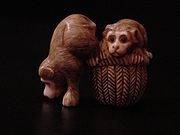
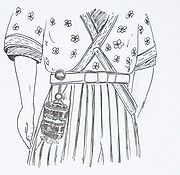
Japan
Japan is an island nation in East Asia. Located in the Pacific Ocean, it lies to the east of the Sea of Japan, China, North Korea, South Korea and Russia, stretching from the Sea of Okhotsk in the north to the East China Sea and Taiwan in the south...
to serve a practical function (the two Japanese characters ne+tsuke mean "root" and "to attach"). Traditional Japanese garments—robes called kosode
Kosode
The kosode is a basic Japanese robe for both men and women. Worn as both an undergarment and overgarment, it is what most people imagine when using the much broader term kimono. The literal meaning of the term kosode is "small sleeve," which refers to the sleeve opening.Kosode are T-shaped, have a...
and kimono
Kimono
The is a Japanese traditional garment worn by men, women and children. The word "kimono", which literally means a "thing to wear" , has come to denote these full-length robes...
—had no pockets; however, men who wore them needed a place to store their personal belongings, such as pipes, tobacco, money, seals, or medicines.
Their solution was to place such objects in containers (called sagemono) hung by cords from the robes' sashes (obi
Obi (sash)
is a sash for traditional Japanese dress, keikogi worn for Japanese martial arts, and a part of kimono outfits.The obi for men's kimono is rather narrow, wide at most, but a woman's formal obi can be wide and more than long. Nowadays, a woman's wide and decorative obi does not keep the kimono...
). The containers may have been pouches or small woven baskets, but the most popular were beautifully crafted boxes (inro
Inro
An is a traditional Japanese case for holding small objects. Because traditional Japanese garb lacked pockets, objects were often carried by hanging them from the obi, or sash. Most types of these sagemono were created for specialized contents, such as tobacco, pipes, writing brush and ink, but...
), which were held shut by ojime
Ojime
' are a type of bead which originated in Japan. They were worn between the inro and netsuke and are typically under an inch in length. Each is carved into a particular shape and image, similar to the netsuke, though smaller....
, which were sliding beads on cords. Whatever the form of the container, the fastener that secured the cord at the top of the sash was a carved, button-like toggle called a netsuke.
Netsuke, like the inro and ojime, evolved over time from being strictly utilitarian into objects of great artistic merit and an expression of extraordinary craftsmanship. Such objects have a long history reflecting the important aspects of Japanese folklore and life. Netsuke production was most popular during the Edo period
Edo period
The , or , is a division of Japanese history which was ruled by the shoguns of the Tokugawa family, running from 1603 to 1868. The political entity of this period was the Tokugawa shogunate....
in Japan, around 1615-1868. Today, the art lives on, and some modern works can command high prices in the UK, Europe, the USA, Japan and elsewhere. Inexpensive yet faithful reproductions are available in museums and souvenir shops.
Forms of netsuke

- katabori netsuke (形彫根付) or "sculpture netsuke" - This is the most common type of netsuke. They are compact three-dimensional figures carved in a round shape and are usually around one to three inches high.

- anaborinetsuke (穴彫根付) or "hollowed netsuke" - subset of katabori which are carved out for a hollow center. Clams are most commonly the motifs for this type of netsuke.

- sashinetsuke (差根付) - This is an elongated form of katabori, literally "stab" netsuke, similar in length to the sticks and gourds used as improvised netsuke before carved pieces were produced. They are about six inches long.
- obi-hasami - another elongated netsuke with a curved top and bottom. It sits behind the obi with the curved ends visible above and below the obi.

- mennetsuke (面根付) or "mask netsuke" - the largest category after katabori. These were often imitations of full-size nohNoh, or - derived from the Sino-Japanese word for "skill" or "talent" - is a major form of classical Japanese musical drama that has been performed since the 14th century. Many characters are masked, with men playing male and female roles. Traditionally, a Noh "performance day" lasts all day and...
masks and share characteristics in common with both katabori and manju/kagamibuta.

- manjunetsuke (饅頭根付) or manju netsuke- a thick, flat, round netsuke, with carving usually done in reliefReliefRelief is a sculptural technique. The term relief is from the Latin verb levo, to raise. To create a sculpture in relief is thus to give the impression that the sculpted material has been raised above the background plane...
, sometimes made of two ivory halves. Shaped like a manjuManju (food)is a popular traditional Japanese confection. There are many varieties of manjū, but most have an outside made from flour, rice powder and buckwheat and a filling of an , made from boiled azuki beans and sugar. They are boiled together again and kneaded...
, a Japanese confection.

- ryusanetsuke (柳左根付)- shaped like a manju, but carved like lace, so that light is transmitted through the item.

- kagamibutanetsuke (鏡蓋根付) or "mirror-lid netsuke" - shaped like a manju, but with a metal disc serving as a lid to a shallow bowl, usually of ivory. The metal is often highly decorated with a wide variety of metallurgical techniques.
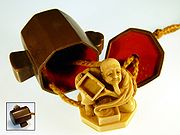
- karakurinetsuke (からくり根付) or "trick/mechanism netsuke" - any netsuke that has moving parts or hidden surprises.
Materials
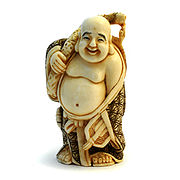

- ivoryIvoryIvory is a term for dentine, which constitutes the bulk of the teeth and tusks of animals, when used as a material for art or manufacturing. Ivory has been important since ancient times for making a range of items, from ivory carvings to false teeth, fans, dominoes, joint tubes, piano keys and...
- the most common material used before ivory from live animals became illegal. Netsuke made from mammothMammothA mammoth is any species of the extinct genus Mammuthus. These proboscideans are members of Elephantidae, the family of elephants and mammoths, and close relatives of modern elephants. They were often equipped with long curved tusks and, in northern species, a covering of long hair...
ivory (huge quantities still exist in the Near East and Siberia) fill part of the tourist trade demand today. - boxwoodBuxusBuxus is a genus of about 70 species in the family Buxaceae. Common names include box or boxwood ....
, other hardwoodHardwoodHardwood is wood from angiosperm trees . It may also be used for those trees themselves: these are usually broad-leaved; in temperate and boreal latitudes they are mostly deciduous, but in tropics and subtropics mostly evergreen.Hardwood contrasts with softwood...
s - popular materials in Edo Japan and still used today - metalMetalA metal , is an element, compound, or alloy that is a good conductor of both electricity and heat. Metals are usually malleable and shiny, that is they reflect most of incident light...
- used as accents in many netsuke and kagamibuta lids - hippopotamusHippopotamusThe hippopotamus , or hippo, from the ancient Greek for "river horse" , is a large, mostly herbivorous mammal in sub-Saharan Africa, and one of only two extant species in the family Hippopotamidae After the elephant and rhinoceros, the hippopotamus is the third largest land mammal and the heaviest...
tooth - used in lieu of ivory today - boarBoarWild boar, also wild pig, is a species of the pig genus Sus, part of the biological family Suidae. The species includes many subspecies. It is the wild ancestor of the domestic pig, an animal with which it freely hybridises...
tuskTuskTusks are elongated, continuously growing front teeth, usually but not always in pairs, that protrude well beyond the mouth of certain mammal species. They are most commonly canines, as with warthogs, wild boar, and walruses, or, in the case of elephants and narwhals, elongated incisors...
- mostly used by the Iwami carvers - rhinocerosRhinocerosRhinoceros , also known as rhino, is a group of five extant species of odd-toed ungulates in the family Rhinocerotidae. Two of these species are native to Africa and three to southern Asia....
horn - hornbill ivoryHornbill ivoryHornbill ivory is a precious ornamental material derived from the Helmeted Hornbill , a large bird of the Malay Peninsula, Sumatra, and Borneo....
- clayClayClay is a general term including many combinations of one or more clay minerals with traces of metal oxides and organic matter. Geologic clay deposits are mostly composed of phyllosilicate minerals containing variable amounts of water trapped in the mineral structure.- Formation :Clay minerals...
/porcelainPorcelainPorcelain is a ceramic material made by heating raw materials, generally including clay in the form of kaolin, in a kiln to temperatures between and... - lacquerLacquerIn a general sense, lacquer is a somewhat imprecise term for a clear or coloured varnish that dries by solvent evaporation and often a curing process as well that produces a hard, durable finish, in any sheen level from ultra matte to high gloss and that can be further polished as required...
- caneArundoArundo is a genus of two or three species of cane: stout, perennial grasses from the family Poaceae, native to the Mediterranean region east to India, China and Japan. They grow to 3–6 m tall, occasionally to 10 m, with leaves 30-60 cm long and 3-6 cm broad.- Species :* Arundo...
(woven)
Unusual materials used in netsuke
- Hornbill ivoryHornbill ivoryHornbill ivory is a precious ornamental material derived from the Helmeted Hornbill , a large bird of the Malay Peninsula, Sumatra, and Borneo....
: Of the many species of hornbillHornbillHornbills are a family of bird found in tropical and subtropical Africa, Asia and Melanesia. They are characterized by a long, down-curved bill which is frequently brightly-colored and sometimes has a casque on the upper mandible. Both the common English and the scientific name of the family...
, only the helmeted hornbillHelmeted HornbillThe Helmeted Hornbill is a very large bird in the hornbill family. It is found in the Malay peninsula, Sumatra and Borneo....
(Buceros vigil or Rhinoplax vigil) furnishes an ivory-like substance. This is a dense, carvable substance that makes up the solid casque growing above the upper mandible (from the bird's forehead). It is not ivory, horn, or bone, yet it has been called ivory for many centuries. It is softer than real ivory and is a creamy yellow in color, becoming red at the top and sides.
- Umimatsu: A species of black coralBlack coralBlack corals are a group of deep water, tree-like corals related to sea anemones. They are also found in rare dark shallow water areas such as New Zealand's Milford Sound where they can be viewed from an underwater observatory. They normally occur in the tropics...
with dense texture, concentric growth rings, and amber and reddish colored inclusions in the black material. According to Michael Birch, "The literal translation of umimatsu is 'sea pine', and it is also popularly described as 'black coral'. True coral, however, is a hard calcareous substance secreted by marine polyps for habitation. Umimatsu, on the other hand is a colony of keratinKeratinKeratin refers to a family of fibrous structural proteins. Keratin is the key of structural material making up the outer layer of human skin. It is also the key structural component of hair and nails...
ous antipatharian marine organisms."
- According to Bushell (13/ 2:6), "The literal translation . . . is seapine. . . . Whether literal or figurative the translation is a misnomer, as the material is, in actuality, a coral formed by skeletons of living organisms. . . . In color, umimatsu, black coral, is black or blackish brown, sometimes showing streaks of light brown or dirty yellow." Bushell goes on: "As material, umimatsu is more acceptable to collectors than carvers. Leading carvers naturally avoided the material. It was prone to crack, crumble or chip. Carvers find that it is risky for carving details and subtle effects. Perfect pieces of black coral were difficult to obtain."
- Umoregi: There are several definitions, some contradictory: According to Bushell, "Umoregi is a partially fossilized woodPetrified woodPetrified wood is the name given to a special type of fossilized remains of terrestrial vegetation. It is the result of a tree having turned completely into stone by the process of permineralization...
, having the general appearance of ebony but showing no grain." Often called fossilized wood, umoregi is not properly a wood, but a "jet" (a variety of ligniteLigniteLignite, often referred to as brown coal, or Rosebud coal by Northern Pacific Railroad,is a soft brown fuel with characteristics that put it somewhere between coal and peat...
), that is often confused with ebony. It is a shiny material that takes an excellent polish, but it has a tendency to split. Umoregi is petrified wood formed when cedarCedar woodCedar wood comes from several different trees that grow in different parts of the world, and may have different uses.* California incense-cedar, from Calocedrus decurrens, is the primary type of wood used for making pencils...
and pinePinePines are trees in the genus Pinus ,in the family Pinaceae. They make up the monotypic subfamily Pinoideae. There are about 115 species of pine, although different authorities accept between 105 and 125 species.-Etymology:...
trees from the Tertiary AgeTertiaryThe Tertiary is a deprecated term for a geologic period 65 million to 2.6 million years ago. The Tertiary covered the time span between the superseded Secondary period and the Quaternary...
(5 million years ago) were buried underground and then carbonized. The layers of earth where umoregi-zaiku can be found extend under the Aobayama and Yagiyama sections of Sendai, [Japan]. Pieces made from this material are generally dark brown with a beautiful wood grain and the soft luster of lacquer.
- WalrusWalrusThe walrus is a large flippered marine mammal with a discontinuous circumpolar distribution in the Arctic Ocean and sub-Arctic seas of the Northern Hemisphere. The walrus is the only living species in the Odobenidae family and Odobenus genus. It is subdivided into three subspecies: the Atlantic...
tusk: Walrus have two large tusks (elongated canine teeth) projecting downward from the upper jaw. These tusks, often reaching two feet in length, have been extensively carved as ivory for centuries in many countries and especially in Japan. Walrus tusk carvings are usually easy to identify, because much of the interior of the tooth is filled with a mottled, almost translucent substance that is harder and more resistant to carving than the rest of the tooth. Manju, especially ryusa manju, invariably show this translucent material at opposite edges of the netsuke.
- WhaleWhaleWhale is the common name for various marine mammals of the order Cetacea. The term whale sometimes refers to all cetaceans, but more often it excludes dolphins and porpoises, which belong to suborder Odontoceti . This suborder also includes the sperm whale, killer whale, pilot whale, and beluga...
's tooth: The sperm whaleSperm WhaleThe sperm whale, Physeter macrocephalus, is a marine mammal species, order Cetacea, a toothed whale having the largest brain of any animal. The name comes from the milky-white waxy substance, spermaceti, found in the animal's head. The sperm whale is the only living member of genus Physeter...
has teeth running the whole length of its enormous lower jaw. Those in the middle tend to be the largest, often obtaining a length of more than six to eight inches. These larger ones are often used by carvers of scrimshawScrimshawScrimshaw is the name given to handiwork created by whalers made from the byproducts of harvesting marine mammals. It is most commonly made out of the bones and teeth of sperm whales, the baleen of other whales, and the tusks of walruses...
. Drexler: "I have a smaller whale's tooth that is just about the size that each of several of my netsuke might have been carved from."
- Whale bone: All bones are hollow, the cavity being filled with a spongy material. Cuts across some bone show a pattern of minute holes looking like dark dots. Lengthwise, such bone displays many narrow channels which appear to be dark lines of varying lengths. Polished, bone is more opaque and less shiny than ivory.
- Teeth: A variety of other teeth are used for netsuke, including: boar's, bearBearBears are mammals of the family Ursidae. Bears are classified as caniforms, or doglike carnivorans, with the pinnipeds being their closest living relatives. Although there are only eight living species of bear, they are widespread, appearing in a wide variety of habitats throughout the Northern...
's, and even tigerTigerThe tiger is the largest cat species, reaching a total body length of up to and weighing up to . Their most recognizable feature is a pattern of dark vertical stripes on reddish-orange fur with lighter underparts...
's.

- Tagua nut: The nut from the ivory palm (Phytelephas aequatorialis), often referred to as vegetable ivory. Part of the nut's shell sometimes remains on netsuke carvings. Though often mistaken for or deceptively sold as elephant ivory, items made from the two-to-three-inch nut have none of the striations common to animal ivory, and sometimes the ivory-like nut flesh has a light yellow cast under a rough coconut-shell-like external covering. The nut is very hard when dry, but easily worked into artistic items when wet.
- WalnutWalnutJuglans is a plant genus of the family Juglandaceae, the seeds of which are known as walnuts. They are deciduous trees, 10–40 meters tall , with pinnate leaves 200–900 millimetres long , with 5–25 leaflets; the shoots have chambered pith, a character shared with the wingnuts , but not the hickories...
(or kurumi - natural walnut shell): In this rare example of the kataborinetsuke (形彫根付) style, the meat from the nut was removed by various means, one being the insertion of a small worm in a hole in the nut to consume the meat. Following that, elaborate designs were carved, and the string inserted. The carver often removed all of the nut's normal surface features and carved through the surface in places to create a latticed effect. Once carved, the resulting netsuke was polished and shellaced.
- BambooBambooBamboo is a group of perennial evergreens in the true grass family Poaceae, subfamily Bambusoideae, tribe Bambuseae. Giant bamboos are the largest members of the grass family....
: "Bamboo (Iyo bamboo) is used for netsuke. Bamboo netsuke are either a piece of the stem or the root with carving on it." According to Bernard Rosett (14/2 :40-44): "Carvings in the round are usually made from the underground stem of the plant, that small almost solid zone that connects to the creeping rhizome below the ground. Bamboo netsuke are not commonly encountered. Occasionally, one comes across a netsuke fashioned from bamboo root and can revel in the wonderful texture and patina of the material."
- AgateAgateAgate is a microcrystalline variety of silica, chiefly chalcedony, characterised by its fineness of grain and brightness of color. Although agates may be found in various kinds of rock, they are classically associated with volcanic rocks and can be common in certain metamorphic rocks.-Etymology...
: A mineral, streaked with many colors, and which can be given a high polish.
- Ivorine: A material made from the dust created when carving legally obtained new ivory, Mammoth ivory, tusks, and teeth, which is then mixed with a clear resinResinResin in the most specific use of the term is a hydrocarbon secretion of many plants, particularly coniferous trees. Resins are valued for their chemical properties and associated uses, such as the production of varnishes, adhesives, and food glazing agents; as an important source of raw materials...
and compressed as it hardens. This was one of the many solutions to the demand of the tourist market trade for netsuke carvings after trade in new ivory became illegal. Once hard and dry, ivorine can be carved in exactly the same way as ivory. Though often deceptively sold to the modern tourist trade as elephant ivory, items made from ivorine have none of the striations common to animal ivory, though sometimes, the carving is artificially aged to have the yellowed appearance common to true old ivory carvings.
Subject categories
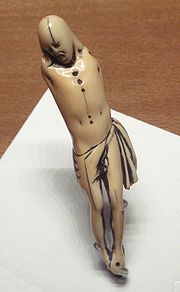
- people - famous and anonymous, current, historical, real and fictitious, children, warriors, priests, etc.
- craft, trades, professions - often depicting actions (fishermen catching fish, woodcutters cutting wood), or examples(i.e., a stylized apple for an orchardist or apple merchant)
- animals - zodiac animals and others. It is worth noting that traditional netsuke style depicts octopus figures as having a tube-like siphon protruding from the "face", similar to a mouth. If one examines closely, one will find that some octopi have nine tentacles instead of eight. These octopi will usually be found embracing beautiful women.
- plants or plant products - Small ones, such as beans or chestnuts, are often carved actual size.
- deities and mythical creatures - often from Chinese mythology and religion
- non-living things - the smallest category. Common examples include roof tiles, coins, and tools.
- abstract - mon patterns and other designs
- sexual - Shunga netsuke may depict a male and female in sexual conjugation or may contain only subtle or symbolic sexual references.
Some netsuke represent single, simple, objects, and some depict entire scenes from history, mythology, or literature.
External links
- International Netsuke Society This organization publishes a journal for collectors and holds international meetings bi-annually. The Society's web site shows examples of different styles. Others can be found by searching the Internet.
- Isaac Kaplan Netsuke Collection. The South African Jewish Museum's collection of over 600 netsuke. The museum's permanent exhibit displays over 200 netsuke from the 17th-19th centuries.
- Japanese Netsuke History and background on various types of netsuke
- Netsuke thumbnail gallery with detailed images at the Bolton Museum web site

